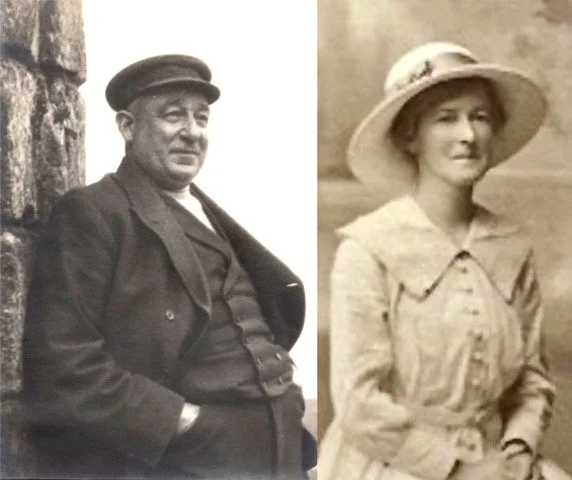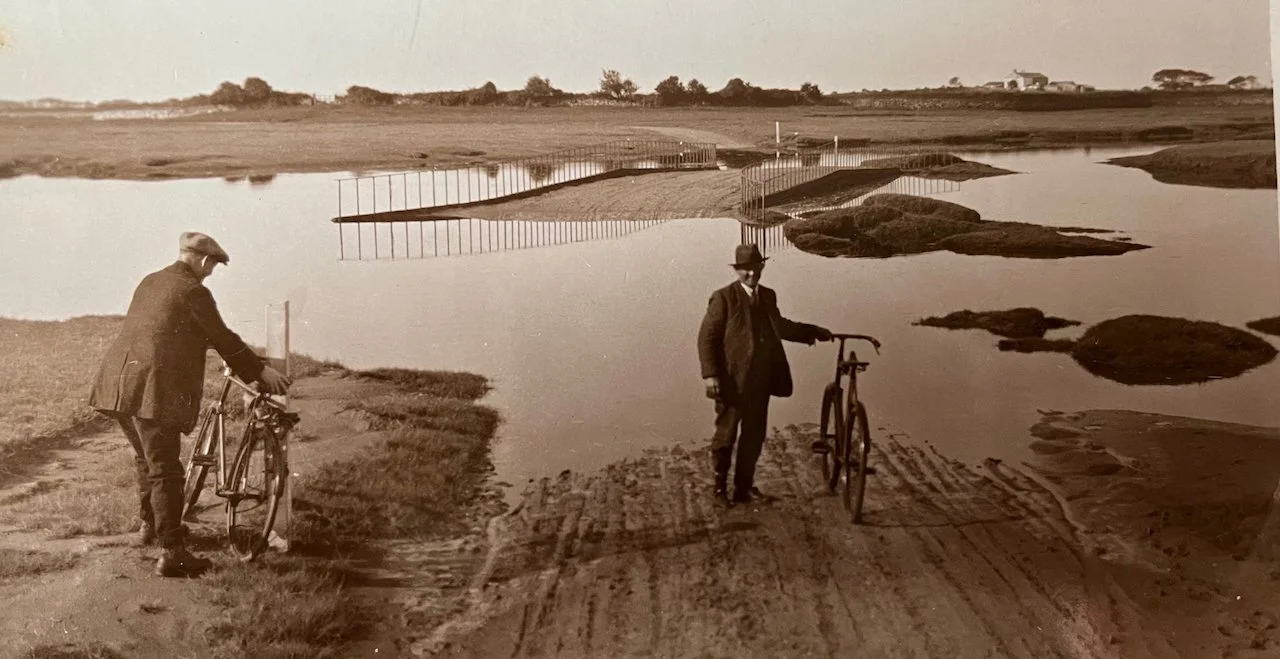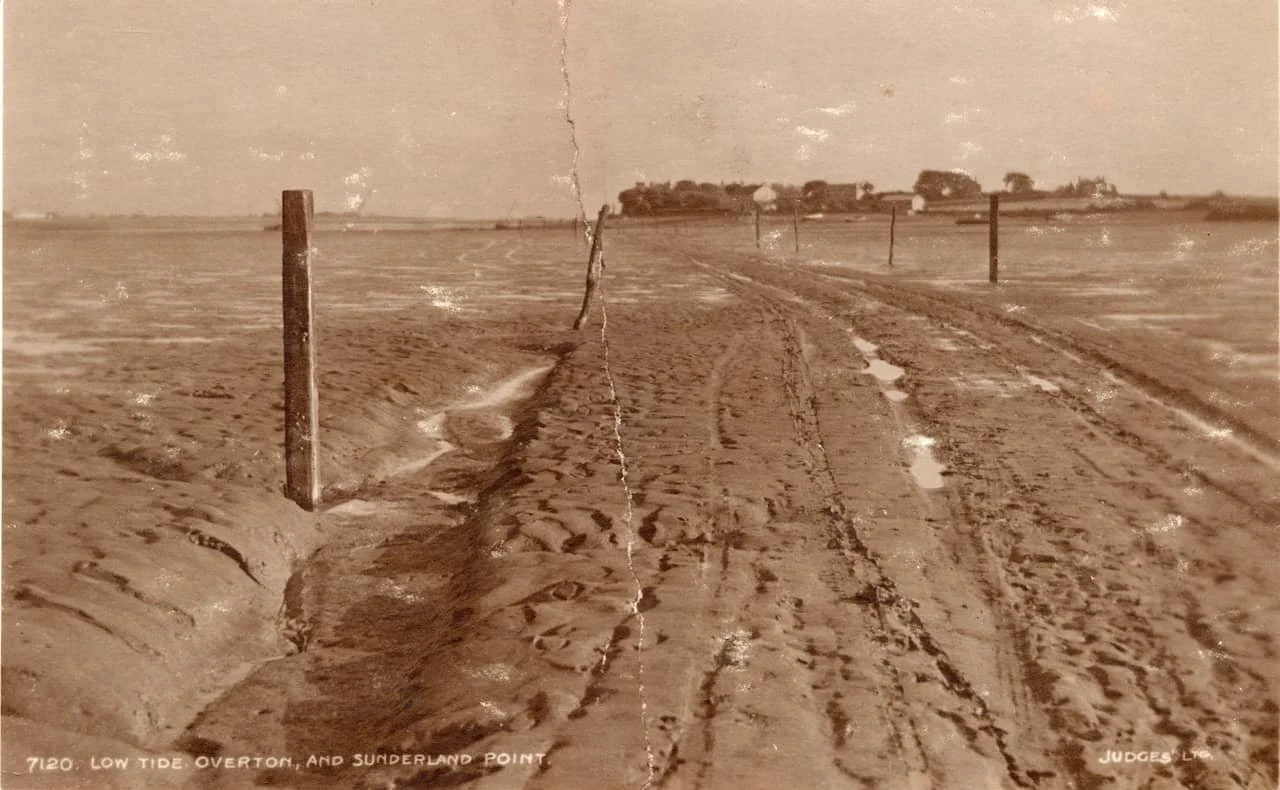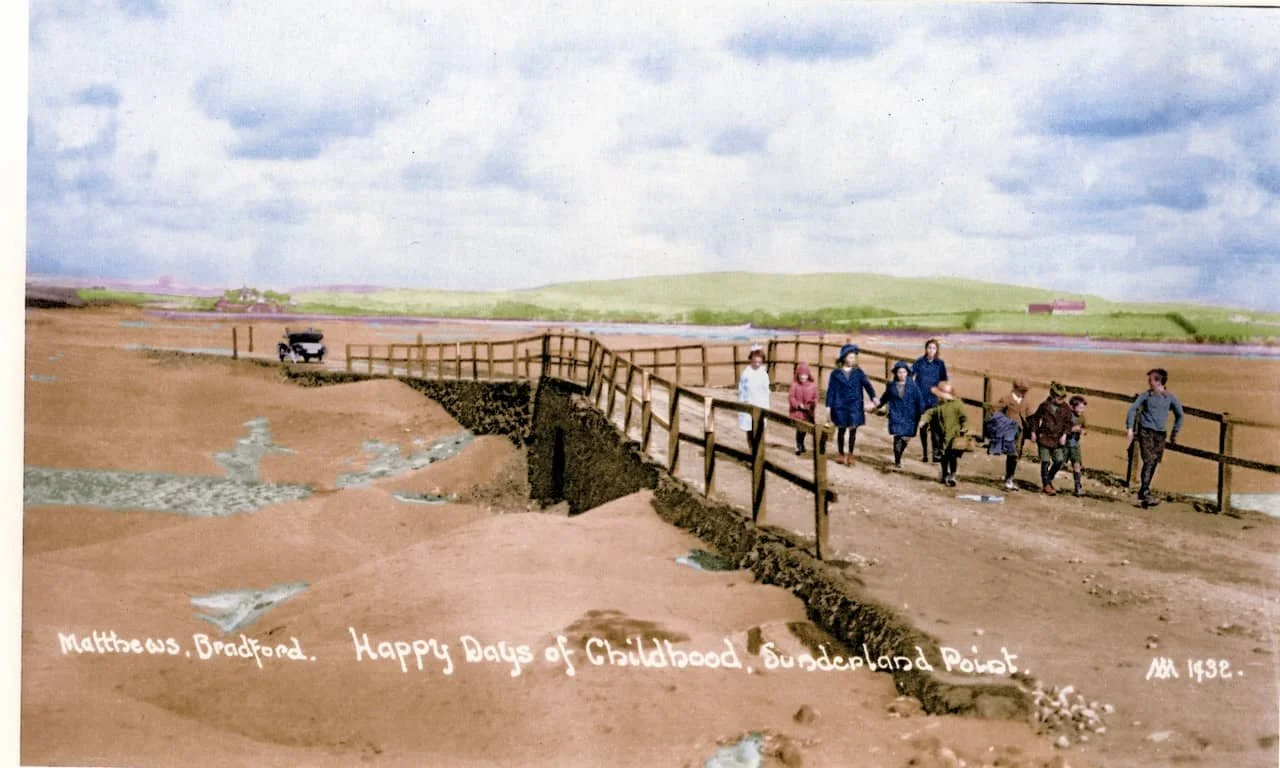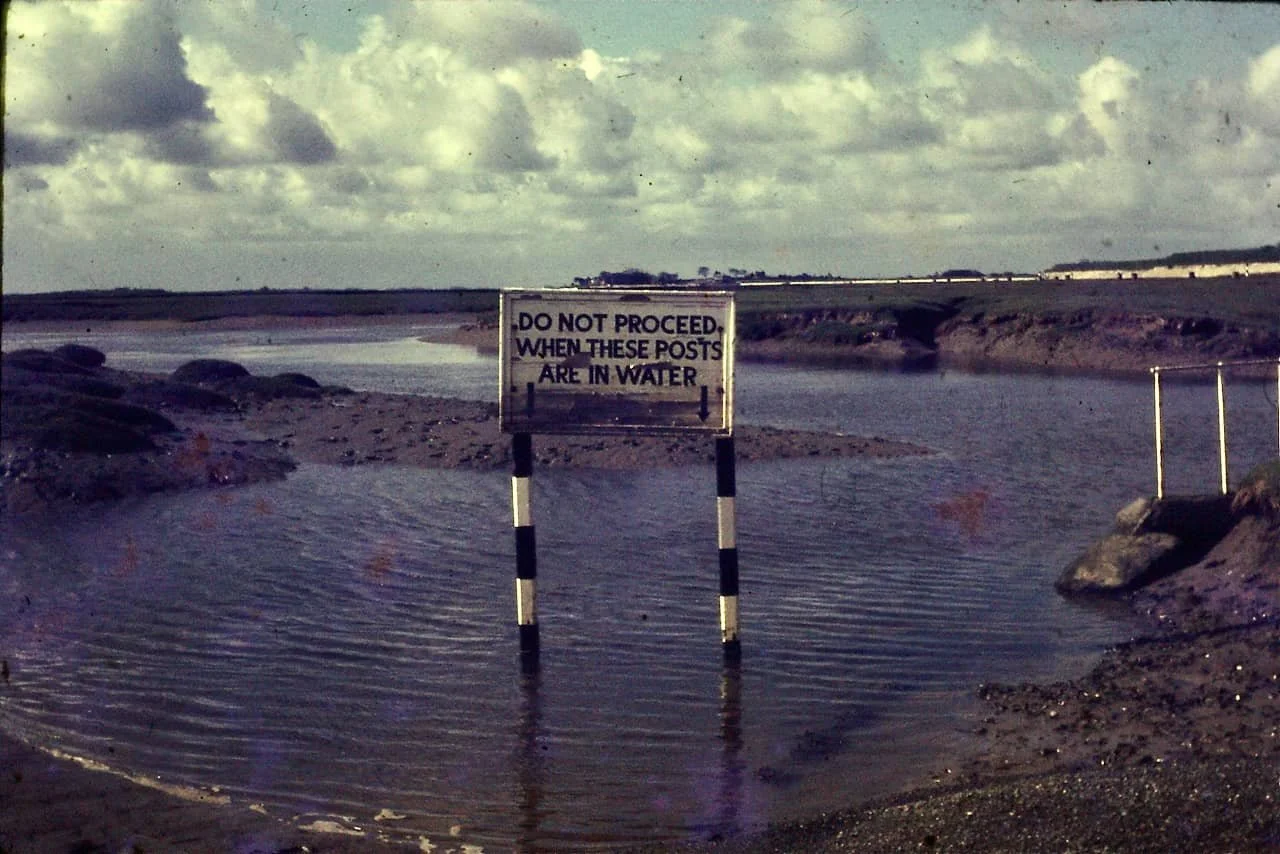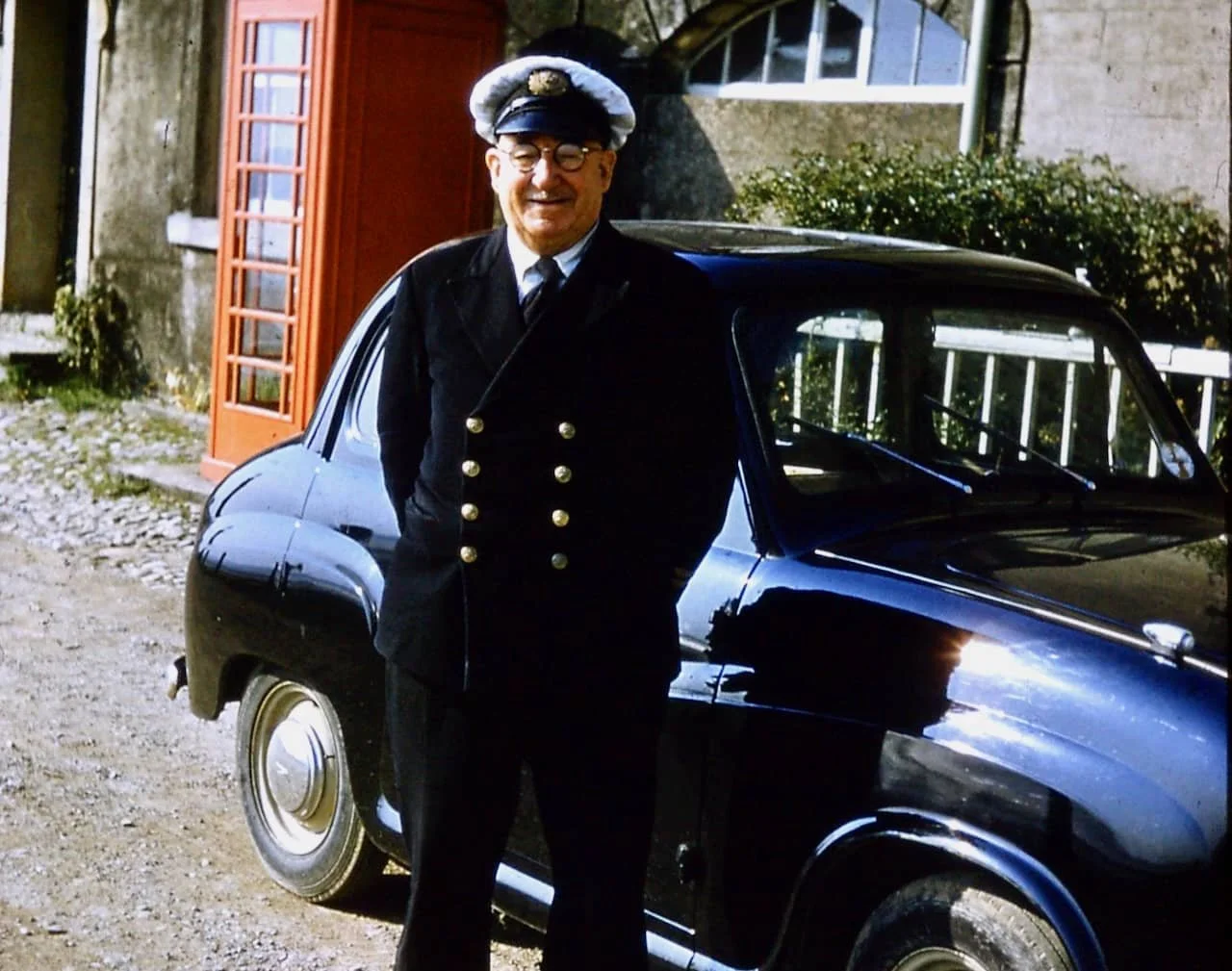A New Road for Sunderland Point -1930s
Mrs White and Mr Gardner - Letters to the Press
On the left, James W. Gardner: Collection Rosemary Lawn. On the right, J. Theodora White: Collection Gilchrist family.
In a fortnight, we plan to publish an article describing the controversial plan to build a new road that would bypass the tidal causeway. This takes place in the period between 1960 and 1980 and marked the culmination of a long-running saga.
Complaints about the causeway can be traced back as far as the 1750s and a search of the newspaper archives reveals numerous articles and letters of complaint about the road. Typically, as well as the poor condition of the road, they write about vehicles caught in the tide and the challenges of getting children to and from school.
Today’s article is a snapshot from the 1930s. These letters cover the possible alternatives, arguments, and even accusations which are similar to those heard in years past and a foretaste of what would be repeated later.
In 1934, following a petition from residents and the support of the Parish Council, the Lancaster Rural District Council recommended the construction of a new road from Overton to Sunderland Point at an estimated cost of £6,800, excluding the purchase of land.
However, vigorous and determined opposition, as well as the costs, sank the scheme, yet it did result in substantial improvements to the road, including, we believe, the first macadam surface.
Strongly worded letters for and against a new road were written to the press during this period; amongst these were several written by James W. Gardner, the fisherman, pilot and finally Harbourmaster at Glasson Dock. James is well known to us from his memoirs and many photographs. He had returned to the village in 1923 and was living with his wife, Fanny, in the Large House, today number 9.
There are also a couple of letters from respected Mrs J. Theodora White. She and her husband, Alfred, had lived in the big red house, the Moorings (number 3), since 1919. Her brother, Philip T. Gilchrist, the artist, lived at Dolphin House (number 12).
Unfortunately, the letters are undated, and the sequence is unclear; however, the content suggests a date in the mid-1930s. Copies were carefully cut from the newspapers by James and pasted into one of his many scrapbooks.
The newspaper cuttings in the scrapbook: Collection Rosemary Lawn
The Letters
(We have taken the liberty to put some words in ‘bold’ for emphasis)
The first letter is from ‘A Villager’, who bemoans the decision of the Rural District Council to turn down the scheme.
‘It is with regret that I learn that the proposed new road to Sunderland Point has been turned down. It must not be lost sight of. Most of the people who signed do not reside at Sunderland point permanently. These people apparently have not thought of the villagers who have to walk to Overton over this bleak Road in all sorts of weather to get a bus or of the school children. Why should Sunderland Point be cut off as it is?
Salmon fishing partners Gerrard Bagot and Bert Smith (right) waiting for the tide: Collection Hugh Cunliffe.
The second letter, signed by ‘Motorist’ weighed in for the opponents:
‘The reason that Sunderland people recently petitioned (and successfully) against a proposed new and costly land road was - they have the sense to see what free access… to the tiny hamlet at all hours of the day - would mean where there is no general public accommodation for large numbers of day visitors.’
And continues with this slight overstatement…
‘On a recent bank holiday, it was estimated that there were a thousand visitors in the place, with results that can be guessed in litter and other refuse. Householders complain of having to lock doors, take in private seats, and make-up gates and stiles to prevent trespass over crops and land, and also of nuisances and damage by strangers who do not understand the place and will even walk into private houses demanding teas and refreshments.
James addresses his first letter in reply to ‘Motorist”.
It is obvious " Motorist" does not reside in the village and, therefore, has not first-hand knowledge of the problem confronting those who reside there.
He would appreciate the difficulty when the road is covered by the tide, sometimes to a depth of ten feet. He knows the road is dangerous, but the stranger does not.’
A rare sight. One of the few motor cars on the road before the 1930s improvements. : Collection Wilton Atkinson.
James makes this controversial statement.
I am convinced that if a secret ballot had been taken, there would have been an overwhelming majority in favour of a new road. Nearly all the villagers favour a new road.’
Reading this, Theodora sends her first letter to the editor.
Doubtless you have no wish to publish any misstatement in your paper.
Consequently, will you allow me to correct some recent remarks about Sunderland Point, to which my attention has been called.
She begins by suggesting most problems could be avoided if proper signs were erected, ‘such as on the Pilling Road’. Then continues:
‘Here are the facts: out of the thirty ratepayers in Sunderland, twenty of them signed against the suggested road. And only eight of the ten who did not sign wanted the road.
Who in the face of these facts is still agitating for a land road and why?
Why are these rather ridiculous attempts being made to overthrow the wishes of a large majority of the people of Sunderland, the land owners, and the decision of the County Council? And for whose benefit are these being done?
Strong words.
In his following letter, James chooses his words carefully.
I have read with care the letter from Mrs Theodore White. This road cannot be compared with the Pilling Road. Whatever type of board was erected here would not stop people and cars coming and getting into difficulties.
As to the reference to the number of ratepayers signing the petition, it is true they are ratepayers but for how long do some of the reside here? Most of them only come in the summer. Some some of those who never use the road signed the petition. Last week this road was underwater for 8 hours every day and for 9 hours foot passengers were held up.
The schoolchildren have many times to change their stockings through having got wet feet.
I have a list of 19 mishaps on the road, which I can vouch for.’
A muddy road before the 1930’s improvements: Collection Hugh Cunliffe
James ends this letter by making another controversial statement:
A new road is required for the benefit not merely of the neighbourhood but for the general body of public who ought to be encouraged to come into this locality.
Theodora does not hesitate; she reaches for her pen and starts by referring to James’s passage encouraging the public to come into the locality:
‘No comment is needed, except perhaps this. There are a few people who could have made a profit out of a road that would bring what may be called disaster, to a quiet, unique, and as yet, unspoiled, little village.
Theodora continues, rebutting James: There are only four schoolchildren.
And then:
May I add that there are eight owners of motor cars who signed the petition against the land road. There are three pilots in Sunderland. The senior pilot, another, and lastly, your correspondent, who has been the local agitator for the road.
An agitator! James.
James chooses his words even more carefully but stands his ground.
May I again assert that I have no other desire than that a safe road should be constructed for the convenience of everybody who cares to come to see us, as well as for ourselves.
It is true there are only four (schoolchildren) but they are entitled to consideration. Only last week, they had to be in Overton by half-past seven in the morning in order to be at school by nine o'clock, the tide being up in the interval. It is true there is a footpath through the fields, but you want thigh boots to get that way.
(The public footpath through thre fields was - and still is – completely sodden in places after heavy rainfall)
Schoolchildren on the road on a dry summer’s day: Collection Wilton Atkinson.
James finishes, ‘I am anxious to see a road provided (which) can (be) use(d) at all times’ and with a dig at Theodora’s only suggested improvement.
‘without it being necessary to erect warning notices’.
We find no further letters between them but is It is noticed with interest that Theodora’s suggestion of a proper notice was implemented.
Morecambe Guardian 7th June 1935
‘A proper warning board has now been erected at the approach to the tidal road to Sunderland Point. There is no doubt that the erection of the board will greatly reduce the number of accidents.’
The 1960s version of ‘the posts are in water’ notice at the start of the road: Collection Peter Hall.
Although there was no new road, there were substantial improvements.
Lancaster Guardian 8th January 1937
Road Improvements
‘Whilst on a visit to the Overton and Middleton district this week a “Guardian” reporter was glad to see an improvement in the condition of the roads. Several tons of stone were being laid on a road which, he understands, is to be carried on to Sunderland Point. This improvement will be greatly appreciated by motorists as there will be no further fear of being stranded when the tide is up.’ (Note: although the road was repaired the risk of being stranded by the tide was almost as great - as we will see next time)
There must have been other letters, but these are the ones James kept.
Bonus Photo.
James W. (Danny) Gardner: Collection of Peter Hall
This is a wonderful photograph of James W. Gardner in his Glasson Dock Harbourmaster's uniform, dating from the late 1950s. He is standing proudly in front of his new-looking Austin A30 motor car.
In his 1995 ‘Notes on the Gardner family’, Wilton Atkinson wrote of James and cars.
‘He was the first villager to own a car, a Model T Ford which had previously been owned by his brother Robert. In order to garage it, the “hull” (a small stone building) at the corner of his brother Tom’s garden (number 2 the Lane) was pulled down and a two storey garage built which was also used for storing nets and other boating equipment – this was about 1927-8. When the Austin 7 was introduced in the 1930’s he had a succession of them changing each year for a newer model (I think the cost of his first Austin was £120 – with a trade in value of £100 after a year). He was a rather heavy-footed driver and his arrival and departure was clearly announced by the revving of his engine.’
